What we have is basically a David and Goliath sort of thing. Goliath, in this case, is Garmin International which sells no less than 28 model variants of its Nuvi-series GPS street navigators. The Davids-two of them, actually-are Control Vision and Bendix/King, who have just introduced GPS navigators that combine both aviation and street navigation functions.
Are buyers really interested in these two capabilities in the same device? Evidently they are, given the number of requests weve received for a hurry-up look at these products. We examined the Bendix/King AV8OR Handheld in the September 2008
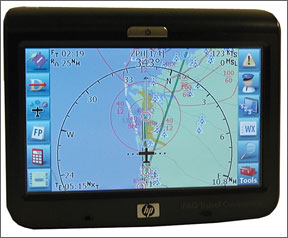
issue and for this report, we’ll look at Control Visions Anywhere Travel Companion, with a sideways glance at Garmins established GPSmap 396/495/496.
HP On the Case
Control Vision unveiled the ATC earlier this year and generated some buzz at Sun n Fun and Oshkosh. This product is less interesting for what it is than what it is not: a PDA or computer. Even though its software architecture is Windows CE, the ATC is a purpose-made navigational platform based on HPs iPAQ 310, which appeared two years ago to make a run at the portable ground navigation market dominated by Garmin.
The ATC is a turnkey version of the 310 loaded with Anywhere Maps aviation navigation software and HPs standard ground nav package. Wisely, Control Vision has made the ATC weather capable through a Bluetooth XM receiver and, as seems to be the fashion these days, it sports an MP3 and video player and will do Bluetooth interface with a headset to control a cellphone. (It doesnt contain a phone, however.) With a dual function XM receiver, the ATC will also tune XM audio programming. At $695 for the basics-aviation and ground nav software but not the weather box-the ATC is an impressive value.
So how we’ll does it work and is it easy to use? The ATC has a couple of limitations. First, processing horsepower. It has a 600MHz ARM-type processor with 128MB of
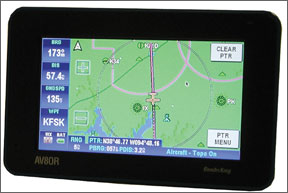
SDRAM. This gets the job done, but we noticed its slow to initiate some applications and, especially when changing screen scales, it needs to chew for awhile. Further, the device soft resets between application changes and is somewhat sluggish in reloading. The screen is a 4.3 inch TFT at 800 x 480 pixels. Not bad on sharpness, but definitely not as sunlight readable as wed like and you need to get the angle just right to avoid glare.
The ATCs physical control set is minimal: just an on/off button and a thumbwheel on the right side of the wafer-thin chassis. A flexible cover hides an antenna jack, a USB port for power and charging and headphone jack. Power is through a removable/rechargeable lithium ion cell that snaps into the back.
Touch and Go
As with Bendix/Kings AV8OR, virtually everything is driven by touchscreen softkeys. The device has a stylus, but we didnt need it much, nor do we think a stylus in the cockpit is a good idea. The softkeys are large enough and sensitive enough to respond to a well-placed finger jab. This didnt seem to trash up the screen surface, but you should keep your hands free of grease and dirt when using the ATC. (It works with gloves, by the way, if you wear those in the cockpit.) Although its Windows-based, the ATC doesnt requiring launching applications in the conventional sense. You just turn it on and after an initial boot-up, you get three choices: aviation navigation, ground navigation and Control Visions unique Pocket Plates, which offer digitized versions of NACO approach plates. This allows another high-level feature: geo-referenced taxi guidance which Control Vision calls Taxi-Express. (Garmins version is SafeTaxi.) This feature depicts the airplanes position on the airport surface relative to runways and taxiways-its an incursion preventer.
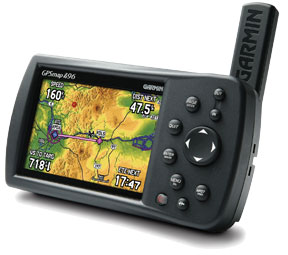
Like navigators before it, the ATC has various map pages or views, including a VFR version, a terrain depiction view, an enroute low-altitude IFR view, an approach view and an emergency page. One unique feature is Anywheres so-called “cones of safety,” which depict the glide range around nearby airports based on the aircrafts current altitude. As with other navigators, the map pages can be customized to suit the user, but the ATC does this differently. Each view can be set up discretely and saved with its own properties, such as navaid depictions, airways, airport details and so on.
As with other navigators with touchscreen capability, you can tap on a waypoint, airport or map feature and a small label pops up with basic data such as frequencies, elevation and distance to the fix. The touchscreen is responsive enough to accept these commands correctly nine out of 10 times-no complaints there.
As for general input of data, the ATC works in two ways. Along the edges of the screen, arrayed vertically, are six icons or toolbars per side, each representing a particular function. Stab the direct-to icon and up pops a dialog box offering a list of nearby airports or a large button offering the option of picking any airport. Punch the latter, and a virtual keyboard appears with keys large enough to make keying in
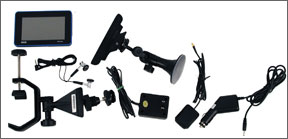
data easy in smooth air, more of a challenge in turbulence. Listed airports can be selected directly by touch stroke and even though the type is small, this seems easy to do.
Weather, Fuel, Ground
The Anywhere products have consistently suffered from two drawbacks. One is the lack of robustness of the iPAQ PDA platforms-connectors and wiring-and the other is the wire demon itself. Control Vision has addressed this in various ways with beefier connectors and mounts and with Bluetooth interface to eliminate wires. The good news is that the ATC makes further progress by eliminating all but the power wire to the navigator itself. Although the 1700 mAh battery will operate the device, it wont do that for long-under three hours, according to our trials. Further, the battery is a slow charger-an overnight plug-in didnt bring it to full capacity. Therefore, we think the battery is really back up, not primary power. Plan on installing the power cable and routing it out of the way. Also, the top-mounted power button is exposed and accidental turn- ons are a concern,
Control Vision nixed another wire by offering only the Bluetooth version of the XM WX box. (Package price with XM WX is $1495, plus the XM activation fee of $75 and either $29.99 a month or $49.99 for XM subscription services. For an additional $6.99, you get audio services and that requires another $19.95 cable for audio feed.
We found that ATCs weather display is comparable to both the AV8OR and Garmin products and the weather data is configurable with regard to whats displayed. You
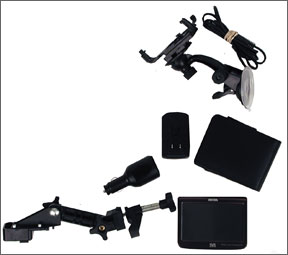
can specify how transparent the weather depiction is, for instance, and set storm tags, lightning and other data. The display is large enough to accommodate the weather-our only complaint is that when panning to look at weather off the display, the ATCs response is slow, in our view. The ATC has a feature none of the others do: a fuel finder. Control Vision maintains a current database of fuel prices at thousands of airports, which it revises via survey. This data is resident in the ATC and kept fresh via downloads from Control Visions Web site. Touch the nearest button and the ATC offers the choice of cheap fuel, indexed to the current position, by navaid or destination. It presents this data in tabular form, with airport ident, price, distance and bearing, plus the age of the data. Considering the price of the fuel these days and the fact that price Deltas of $2 arent uncommon, five 60-gallon fill-ups will pay for the thing. Were surprised Control Vision doesnt promote this more vigorously; its a valuable feature.
As a ground navigator, the ATC is competent. While a higher-priced version of the HP products uses TomTom software, the ATC has Nav N Go, similar to the AV8OR. We found this easy to use without resorting to the manual-which is a good thing, because the product isn’t shipped with one, but you can download it from Control Visions Web site.
For ground nav display, the ATC gives the choice of 2D or 3D, the latter showing buildings, structures and terrain, if selected. Moreover, the perspective view shifts with scale-the higher the scale, the flatter the view.
Turn warnings are adequate and ground routing seems to be comparable to the other products. Keying in destinations is done via the virtual keyboard, by state, city and street name. All three of the ground nav databases feature points of interest such as food, fuel and lodging.
Comparing Them
Straight across the board, how do these units compare? First, lets consider price
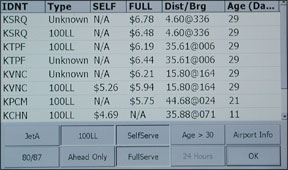
with and without the XM WX option. Sans XM, the AV8OR is selling discounted for $639, while the ATC is $695. Both have broadly comparable features but not the same capabilities, as we’ll note in a moment. Garmins closest comparable option is the new GPSmap495-$1595 discounted. But it doesnt include ground navigation, which is a $239 add-on and weather isn’t an option at all. At $1845 when the ground nav is added, its a distant third in price/value for just the basics. If you add XM WX, the ATC totals $1495, the AV8OR is $1135 discounted, both with Bluetooth. The closest Garmin option is the GPSmap396 at $1795 discounted, plus $239 for the ground nav package. The $2395 GPSmap 496 has XM and ground nav as standard.
Hardware/Display: We give Garmin top marks for the most robust hardware and brightest, sunlight readable display, although its form factor is large compared to the other two. Weve never seen the 396/496 lockup, but both the ATC and AV8OR did.
Operating logic ease: Because of their menu-driven, touchscreen displays, the ATC and Bendix/King are easier to operate and faster to command than the Garmin navigators, which retain the key-and-rocker logic theyve had since the dawn of time. In our view, the AV8OR and ATC are about equal in this regard, even though theyre different. Each has some quirks, but each is learnable.
Aviation functionality: Garmin wins this one by a nose, for several reasons. The display is one, but another is the unique flight panel gyro page, which we have proven can actually back up failed vacuum instruments. Further, Garmins 495/496 sports the SafeTaxi and AOPA Airport Directory data, two other plusses we like. It also loads and flies approaches nearly as we’ll as panel mounts do and its terrain display and warning features are the best, in our view.
The ATC is right behind it, however. Its aviation function is rich with features-too many to list here-and these are flexible and easy to use, especially given the Pocket Plates and fuel finder features, which no one else has. We also like the cones of safety idea and what Control Vision calls the Personal Digital Co-Pilot, a kind of super-smart tank timer with safety checklist, obstacle and upset warnings. Here, the AV8OR finishes a distant third. Its more of a light-duty VFR-only box, lacking the Garmins flight page and approaches and the ATCs approach plates. In
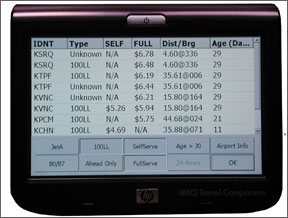
fact, the AV8OR is no help at all on the airport surface. If the ATC didnt exist, this wouldnt be an issue, but it does, so we have to note the AV8ORs warts. Were told that Bendix/King has some upgrades coming and thats good news-we think buyers are going to want these features.
Ground navigation: we’ll give the AV8OR the edge here, although its comparable to the ATC. However, the AV8OR initializes faster and we found its display a bit more readable, especially in sunlight. Both seem equally adept at route calcs and either will get you where youre going complete with turn-by-turn voice callouts.
The Garmins arent as strong at ground navigation, by contrast. Theyll get you there all right, but they lack the nice 3D view of the other two and the key-and-rocker input is just too tedious for us. Newer Garmin dedicated ground navigators-the Nuvi line-blow away the ATC and AV8OR-but those operating features arent integrated into the 396/495/496 and arent likely to be until the next generation arrives.
Weather: Both the AV8OR and ATC use the remote XM WX receiver. The AV8OR can be hardwired or Bluetoothed, but the ATC is Bluetooth only. The Garmins weather receiver is integrated into the XM antenna and, in our view, its the most elegant solution of the three. It also seems to be the most reliable-weve heard few complaints about lockups or lack of performance. One reader told us he had trouble getting the Bendix/King system to process weather correctly and reader Bruce Buchanan of Naples, Florida, phoned to say he returned his ATC because of poor XM performance and dissatisfaction with Control Visions customer service.
Recommendations
Because buyers are usually clear about what theyll pay for something and manufacturers figure that out, prices on like products in a market are rarely more than a dozen percentage points apart. But because Garmin so dominates the GPS market, thats not the case here. At $2395, the top-level GPSmap496 costs more than twice as much as the Bendix/King AV8OR, yet it doesnt do twice as much. But it does do more. Its aviation navigation is second to none, the weather display is rock solid and it has that impressive flight instrument page, all of which run free of lockups and quirks.
Functionally, the AV8OR does the navigation and weather, it just doesnt do it as well, ground navigation excepted. The ATC bests the AV8OR in aviation mode by a wide margin, but we liked the AV8OR better for ground nav. Its also the best value for just weather, if thats your wont.
Which to buy? If top-dog aviation navigation is your goal and youre not budget limited, buy the GPSmap496 and leave it in the airplane. Get a separate ground navigator and carry it in your briefcase or flightbag, saving the hassle of moving these gadgets around and fussing with wiring and mounts. The AV8OR is not a bad choice for this, but Garmins mid-priced Nuvis are also good choices.
The best overall budget choice is definitely the ATC, in our view. Its good in the air and on the ground and Control Vision has done yeomans work in reducing the wiring hassle, plus the device is easy to use. But there are some give ups. The unit is relatively new so its service history and durability are a toss-up and largely dependent on HP. We have concerns about consumer-grade electronics in the cockpit. The real pot sweetener for the ATC, however, is the fuel finder. That alone will make it worth it for some buyers. As for the AV8OR, we think its aviation functions need to be beefed up to run more strongly against the ATC. we’ll be watching for that to happen.





